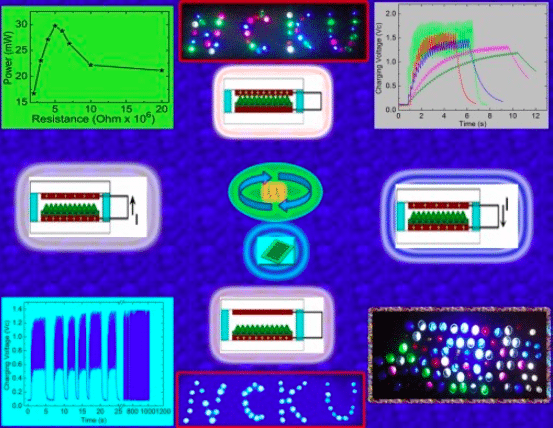
Triboelectric generators (TEG) and triboelectric nanogenerators (TENG) are the friendly-environment, effective mechanical-electrical energy conversion devices [1-5].The principle is based on triboelectric effect and electrostatic induction. The devices normally consist of two triboelectric materials and generate electric performance in the cycling contact-separation mode. The triboelectric materials are very easy to find from metal, non-metal with the function of electrical charge in the contact and friction mode with other tribo-materials.
The PDMS (polydimethylsiloxane) is the effective triboelectric, non-toxic material, and easily formed by a casting process in micro-molds. On the morphology characterization, introducing a structure onto the polymer surface will increase its surface roughness leading to increasing the friction and contact area of the tribo-materials as it is faced to push and rub with other tribo-materials. The role criteria of characterizing TEG/TENG’s electrical performances include the open-circuit voltage (VOC), short-circuit current (ISC), current density (JSC), power, energy storage, and lighting emission to assess for the real power generation applications.
The novel TEGs structure formed of the inclined wall arrays with micro-topping (IWA-MT) PDMS structure based triboelectric generator (IWA-MT-PDMS-TEG) show outstanding characteristics of sustainable mechanical-electrical energy conversion, energy storage, lighting emission, and output performance. Moreover, they are fabricated using a green, low-cost, easy-fabrication CO2 laser-ablation method on the polymethyl methacrylate (PMMA) mold and a polymer casting process. The sustainable IWA-MT-PDMS-TEG consists of easy-finding materials of IWA-MT-PDMS film and aluminum (Al) foil, in that, Al plays two core roles as electrode and tribo-material.
Two special kinds of IWA-MTs were introduced to enhance the power output: the inclined wall arrays with a micro-particle topping PDMS film based triboelectric generator (IWA-MP-PDMS-TEG) and the inclined wall arrays with a splayed micro-dome topping PDMS film based triboelectric generator (IWA-SMD-PDMS-TEG).
In the simple working condition by hand tapping with low frequency, the IWA-MP-PDMS-TEG produces high performance of the maximum VOC of 135.8 V, ISC of 109.5 µA, JSC of 3.5 µA cm-2, the power of 29.7 mW at a 5 MΩ external resistance, and the power density of 9.6 W m-2. And the IWA-SMD-PDMS-TEG generates the maximum VOC of 112.6 V, ISC of 83.5 µA, JSC of 2.7 µA cm-2, the power of 13.8 mW, and the power density of 4.4 W m-2. The both IWA-MT-PDMS-TEGs also showed the good energy storage ability and emission applications. In details, the IWA-MP-PDMS-TEG can charge into a 0.22 μF capacitor with the maximum charged voltage (VC) of 1.74 V at 0.76 sec, stable charging with thousands of times into a 0.1 µF capacitor, and drive 83 LEDs connected in series lighting brightly on by the hand pressing. And also, the IWA-SMD-PDMS-TEG can charge VC of 1.04 V into the same capacitor at 4.5 sec and light 65 LEDs.
The IWA-MTs can enhance the output performance of the TEG because of increase in the contact area and friction between the IWA-MT-PDMS and Al in the contact-separate working cycle. The IWA-MP-PDMS-TEG also shows the stable charging ability for energy storage and bright emission, and direct power to the beautiful real advertising boards. With outstanding characteristics of green, low-cost, quick fabrication, and easy-finding materials for high output power performance, the both IWA-MT-PDMS-TEGs can directly apply into charging, storage, and lighting emission, it also promises to bring bright prospects for practical applications in the near future.
Figure 1 shows the summarization from the design concept to the real applications of the IWA-MT-PDMS-TEG. The center images present the novel structure of IWA-MT-PDMS-TEG come from simple, low-cost, and quick-fabrication method of CO2 laser ablation and polymer casting process, and cyclic working mechanism of the TEG. The top left corner image shows the high power of the energy harvester. The top right corner image shows the electrical charging application. The bottom right corner shows the lighting emission application with tens of colored LEDs. The bottom left corner presents the sustainable working of the device. The top-center and bottom-center images show the advertising board application with the logo letters of NCKU.

Figure 1 From design concept to the real applications of the IWA-MT-PDMS-TEG. The center images present the structure and working mechanism of the TEG. The top left corner image is the power of the device. The top right corner image is the electrical charging application. The bottom right corner is the lighting emission application. The bottom left corner is the sustainable working of the device. The top-center and bottom-center images are the advertising board application with the logo letters of NCKU (Republished with permission from Elsevier)
These findings are described in the article entitled Harvesting mechanical energy, storage, and lighting using a novel PDMS based triboelectric generator with inclined wall arrays and micro-topping structure, recently published in the journal Applied Energy. This work was conducted by V. L. Trinh and C. K. Chung from National Cheng Kung University.
References:
- Wang ZL, Chen J, Lin L. Progress in triboelectric nanogenerators as a new energy technology and self-powered sensors. Energy & Environmental Science. 2015;8:2250-82.
- Liang QJ, Zhang Q, Yan XQ, Liao XQ, Han LH, Yi F, et al. Recyclable and Green Triboelectric Nanogenerator. Advanced Materials. 2017;29:7.
- Xu W, Huang LB, Wong MC, Chen L, Bai GX, Hao JH. Environmentally Friendly Hydrogel-Based Triboelectric Nanogenerators for Versatile Energy Harvesting and Self-Powered Sensors. Advanced Energy Materials. 2017;7:8.
- Trinh VL, Chung CK. A facile method and novel mechanism using microneedlestructured PDMS for triboelectric generator applications. Small 2017;13:1700373
- Cheng XL, Miao LM, Song Y, Su ZM, Chen HT, Chen XX, et al. High Efficiency Power Management and Charge Boosting Strategy for a Triboelectric Nanogenerator. Nano Energy. 2017;38:448-56.









